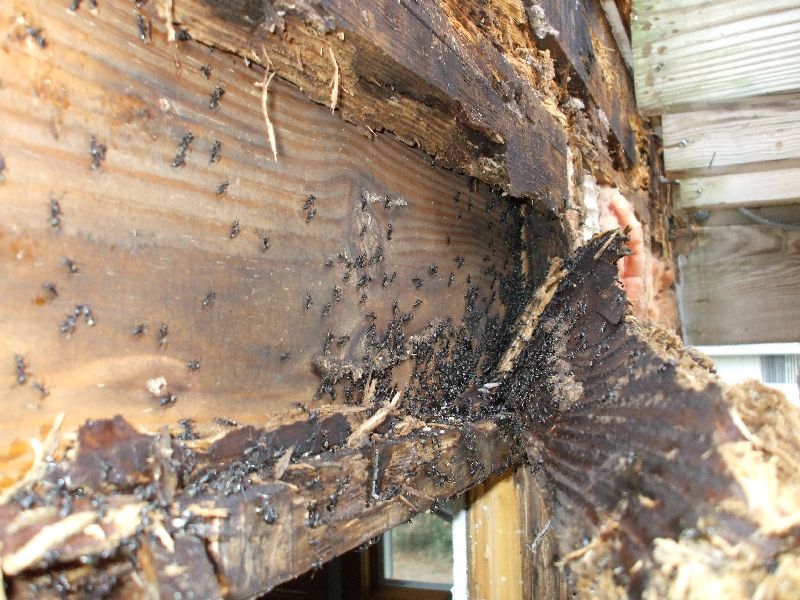Discovering mice, bats, rats, raccoons, bats, termites, birds, or squirrels in your attic can be unsettling, but there are ways to get rid of house pests. Recognizing the signs early can help you tackle the problem before it escalates.
How to find out which critter is living in your attic
Keep in mind that some critters—rats, raccoons, bats, and mice—are nocturnal. So, you will need to look and listen for the signs so you can best strategize how to get rid of house pests.
Mice
Look out for droppings, which are small and dark, typically concentrated in areas where mice are feeding or nesting. You might also hear scurrying or scratching sounds above you, especially at night when mice are most active. Gnaw marks on wood, insulation, or stored items and nesting materials such as shredded paper or fabric can also indicate their presence. You may also see tunneling through insulation.
Squirrels
Do you hear scurrying in the morning? Maybe a few squeak noises coming from the attic? It could be a squirrel. If there is a squirrel, you’ll probably see a nest and discarded acorn shells, too.
Raccoons
If you hear louder noises like a thumping sound coming from the attic, it could be a raccoon. Baby raccoons can be heard whining during the day, too. Typically babies are born in spring and summer. You may also see paw prints. These are larger than a squirrel’s prints, and are unlike possum prints that are triangular and 5-fingered.
Bats
Fluttering noises at night, scratching sounds, and chirps can indicate a bat that’s moved into your attic space. You’ll likely see guano—bat droppings—that are like long pellets. Guano is also dangerous for humans to breathe.
Snake
If you see a snakeskin in your attic, you’ve had a slithering visitor. And a snake may have moved in if there’s a population of tasty animals already there. Their excrement is similar to a bird’s, but is usually less white in color.
If you notice any of these signs, it’s time to take action.
Fix Holes in the Roof
Mice and other pests can enter through incredibly small openings, as small as a dime. Inspecting your attic for any holes or gaps in the roof is a crucial first step. Pay special attention to areas where vents and utility pipes exit the roof, as these can often provide the perfect entrance for these tiny intruders. Use sturdy materials like metal flashing or metal hardware mesh cloth to seal off these openings. Not only will this prevent new mice from entering, but it also enhances the overall insulation of your attic, helping maintain a more consistent temperature throughout your home.
Add Insulation
Adding insulation to your attic doesn’t just improve energy efficiency; it can also deter mice. By filling in gaps and reducing open spaces, you limit the areas where mice can nest. Moreover, a well-insulated and finished attic becomes a more viable space for regular use, whether for storage or as an additional living area. Frequent human activity is a natural deterrent for mice, who prefer quiet, undisturbed places to set up their home. Consider using insulation materials that are less appealing for nesting, like foiled-faced insulations, which are difficult for mice to chew through.
Get a Cat
Sometimes, the old-fashioned solutions are the best! A obvious way to get rid of house pests is by introducing a predator. Cats are natural predators of mice and just the presence of a feline in your home can be enough to keep these rodents at bay. While not everyone may be a cat person, adopting a cat not only gives you a loving pet but also a diligent guard against mouse intruders. Even if you aren’t ready for a pet, occasionally borrowing a neighbor’s cat can have a similar deterrent effect. Mice can detect their predators’ scent and will steer clear of an area where cats frequent.
Reach Out to Professionals to Get Rid of House Pests
While many homeowners are adept at DIY solutions, a severe mouse infestation might require professional intervention. Pest control services can offer more comprehensive solutions such as baits, traps, and even structural modifications that are not typically available to the average homeowner. They can also provide a more systematic approach to not only removing the current population but preventing future infestations. Engaging professionals ensures that the job is done safely and effectively, and often comes with the reassurance of follow-up services to guarantee a rodent-free home.
Mice and other pests in the attic can be more than just a nuisance; they can pose serious health risks and cause physical damage to your home. By taking proactive steps to get rid of house pests, such as sealing up entry points, enhancing insulation, employing natural predators, and possibly seeking professional help, you can protect your home and return your attic to a safe, clean part of your living space. Remember, the key to successful rodent management is persistence and a comprehensive approach to prevention and removal.
About the Author




